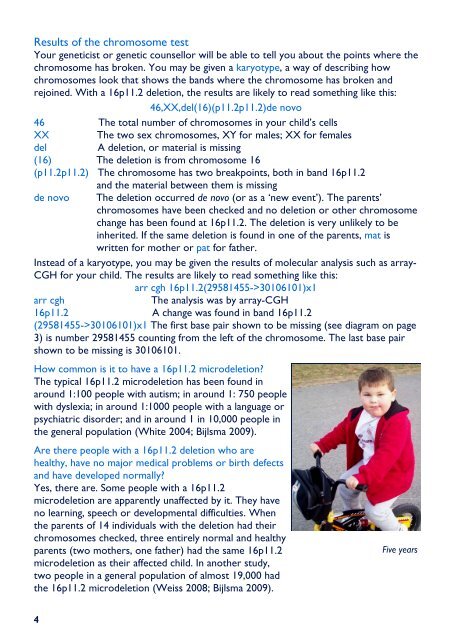16p proximal deletions - Unique - The Rare Chromosome Disorder ...
16p proximal deletions - Unique - The Rare Chromosome Disorder ...
16p proximal deletions - Unique - The Rare Chromosome Disorder ...
You also want an ePaper? Increase the reach of your titles
YUMPU automatically turns print PDFs into web optimized ePapers that Google loves.
Results of the chromosome test<br />
Your geneticist or genetic counsellor will be able to tell you about the points where the<br />
chromosome has broken. You may be given a karyotype, a way of describing how<br />
chromosomes look that shows the bands where the chromosome has broken and<br />
rejoined. With a <strong>16p</strong>11.2 deletion, the results are likely to read something like this:<br />
46,XX,del(16)(p11.2p11.2)de novo<br />
46 <strong>The</strong> total number of chromosomes in your child’s cells<br />
XX <strong>The</strong> two sex chromosomes, XY for males; XX for females<br />
del A deletion, or material is missing<br />
(16) <strong>The</strong> deletion is from chromosome 16<br />
(p11.2p11.2) <strong>The</strong> chromosome has two breakpoints, both in band <strong>16p</strong>11.2<br />
and the material between them is missing<br />
de novo <strong>The</strong> deletion occurred de novo (or as a ‘new event’). <strong>The</strong> parents’<br />
chromosomes have been checked and no deletion or other chromosome<br />
change has been found at <strong>16p</strong>11.2. <strong>The</strong> deletion is very unlikely to be<br />
inherited. If the same deletion is found in one of the parents, mat is<br />
written for mother or pat for father.<br />
Instead of a karyotype, you may be given the results of molecular analysis such as array-<br />
CGH for your child. <strong>The</strong> results are likely to read something like this:<br />
arr cgh <strong>16p</strong>11.2(29581455->30106101)x1<br />
arr cgh <strong>The</strong> analysis was by array-CGH<br />
<strong>16p</strong>11.2 A change was found in band <strong>16p</strong>11.2<br />
(29581455->30106101)x1 <strong>The</strong> first base pair shown to be missing (see diagram on page<br />
3) is number 29581455 counting from the left of the chromosome. <strong>The</strong> last base pair<br />
shown to be missing is 30106101.<br />
How common is it to have a <strong>16p</strong>11.2 microdeletion?<br />
<strong>The</strong> typical <strong>16p</strong>11.2 microdeletion has been found in<br />
around 1:100 people with autism; in around 1: 750 people<br />
with dyslexia; in around 1:1000 people with a language or<br />
psychiatric disorder; and in around 1 in 10,000 people in<br />
the general population (White 2004; Bijlsma 2009).<br />
Are there people with a <strong>16p</strong>11.2 deletion who are<br />
healthy, have no major medical problems or birth defects<br />
and have developed normally?<br />
Yes, there are. Some people with a <strong>16p</strong>11.2<br />
microdeletion are apparently unaffected by it. <strong>The</strong>y have<br />
no learning, speech or developmental difficulties. When<br />
the parents of 14 individuals with the deletion had their<br />
chromosomes checked, three entirely normal and healthy<br />
parents (two mothers, one father) had the same <strong>16p</strong>11.2<br />
microdeletion as their affected child. In another study,<br />
two people in a general population of almost 19,000 had<br />
the <strong>16p</strong>11.2 microdeletion (Weiss 2008; Bijlsma 2009).<br />
4<br />
Five years

















